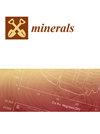Crystallization Sequence of the Spodumene-Rich Alijó Pegmatite (Northern Portugal) and Related Metasomatism on Its Host Rock
IF 2.2
4区 地球科学
Q2 GEOCHEMISTRY & GEOPHYSICS
引用次数: 0
Abstract
The Barroso–Alvão region is an excellent setting for studying Li mineralization associated with granitic pegmatites and developing Li exploration techniques. Among the distinguished pegmatite types in this pegmatite field, the spodumene-bearing dyke from Alijó is a representative example of an Iberian Li–Cs–Ta (LCT) pegmatite currently under exploitation. In this work, we examine the internal evolution of the Alijó dyke and its external metasomatic effect on the surrounding metasediments, contributing to lithium exploration techniques. Electron microprobe analyses provided clues about the crystallization conditions and the degree of differentiation of the pegmatitic melt, whereas the external metasomatism induced by the spodumene-bearing pegmatite was studied through whole-rock geochemistry. The obtained results indicate that the primary crystallization of the studied dyke likely occurred at temperatures between 450–500 °C, with emplacement at shallow crustal levels of about 2–3 kbar. The high concentrations of trace elements such as Li, Cs, Rb, Be, Sn, Nb, Ta, Ge, U, and Tl in the pegmatitic melt suggests high availability of these elements, allowing their partitioning into an early exsolved fluid phase. The exsolution of this fluid phase, subtracting components such as F and B, from the pegmatitic melt would cause a significant undercooling of the melt. Moreover, the interaction of this expelled fluid with the country rock generated a metasomatic overprint in the surrounding metasedimentary host rocks. The metasomatic effect in Alijó is strongly influenced by the nature of the host metasediments, with a significantly higher grade of metasomatism observed in pelitic (mica-rich) samples compared to psammitic (mica-poor) samples collected at same distances from the dyke. The greisen developed close to the pegmatite contact reflects this metasomatic signature, characterized by the mobilization of at least B, F, Li, Rb, Cs, Sn, Be, Nb, Ta, and Tl. We cautiously suggest that whole rock Li concentrations greater than 300 ppm, combined with a minimum value of 1000 ppm for the sum of B, F, Li, Rb, Cs, and Sn in pelitic metasediments of Barroso–Alvão, may be indicative of a mineralized pegmatite in this region.富含 Spodumene 的 Alijó伟晶岩(葡萄牙北部)的结晶序列及其主岩的相关变质作用
巴罗佐-阿尔旺地区是研究与花岗伟晶岩相关的锂矿化和开发锂勘探技术的绝佳地点。在该伟晶岩区的各种类型伟晶岩中,来自 Alijó 的含spodumene岩堤是目前正在开发的伊比利亚锂-铯-钽(LCT)伟晶岩的一个代表。在这项工作中,我们研究了 Alijó 堤的内部演化及其对周围基岩的外部变质作用,为锂勘探技术做出了贡献。电子微探针分析为伟晶岩熔体的结晶条件和分化程度提供了线索,而通过全岩地球化学则研究了含钠伟晶岩引起的外部变质作用。研究结果表明,所研究的伟晶岩的初级结晶可能发生在 450-500 °C之间的温度,并在约2-3千巴的浅地壳水平发生。伟晶岩熔体中痕量元素(如 Li、Cs、Rb、Be、Sn、Nb、Ta、Ge、U 和 Tl)的高浓度含量表明,这些元素的可用性很高,使它们能够被分隔到早期的外溶液相中。这种流体相的外溶,减去了伟晶岩熔体中的 F 和 B 等成分,会导致熔体严重过冷。此外,这种被排出的流体与乡土岩的相互作用在周围的变质岩主岩中产生了变质叠印。阿里霍的变质作用受主岩性质的强烈影响,在距堤坝相同距离采集的辉长岩(富含云母)样本中观察到的变质程度明显高于辉长岩(贫云母)样本。在伟晶岩接触面附近发育的灰岩反映了这种变质特征,其特点是至少动员了 B、F、Li、Rb、Cs、Sn、Be、Nb、Ta 和 Tl。我们谨慎地认为,在巴罗佐-阿尔旺的辉长岩中,全岩锂浓度大于 300 ppm,加上硼、萤石、锂、铷、铯和锡总和的最低值为 1000 ppm,这可能表明该地区存在矿化伟晶岩。
本文章由计算机程序翻译,如有差异,请以英文原文为准。
求助全文
约1分钟内获得全文
求助全文
来源期刊

Minerals
MINERALOGY-MINING & MINERAL PROCESSING
CiteScore
4.10
自引率
20.00%
发文量
1351
审稿时长
19.04 days
期刊介绍:
Minerals (ISSN 2075-163X) is an international open access journal that covers the broad field of mineralogy, economic mineral resources, mineral exploration, innovative mining techniques and advances in mineral processing. It publishes reviews, regular research papers and short notes. Our aim is to encourage scientists to publish their experimental and theoretical results in as much detail as possible. There is no restriction on the length of the papers. The full experimental details must be provided so that the results can be reproduced.
文献相关原料
| 公司名称 | 产品信息 | 采购帮参考价格 |
|---|
 求助内容:
求助内容: 应助结果提醒方式:
应助结果提醒方式:


